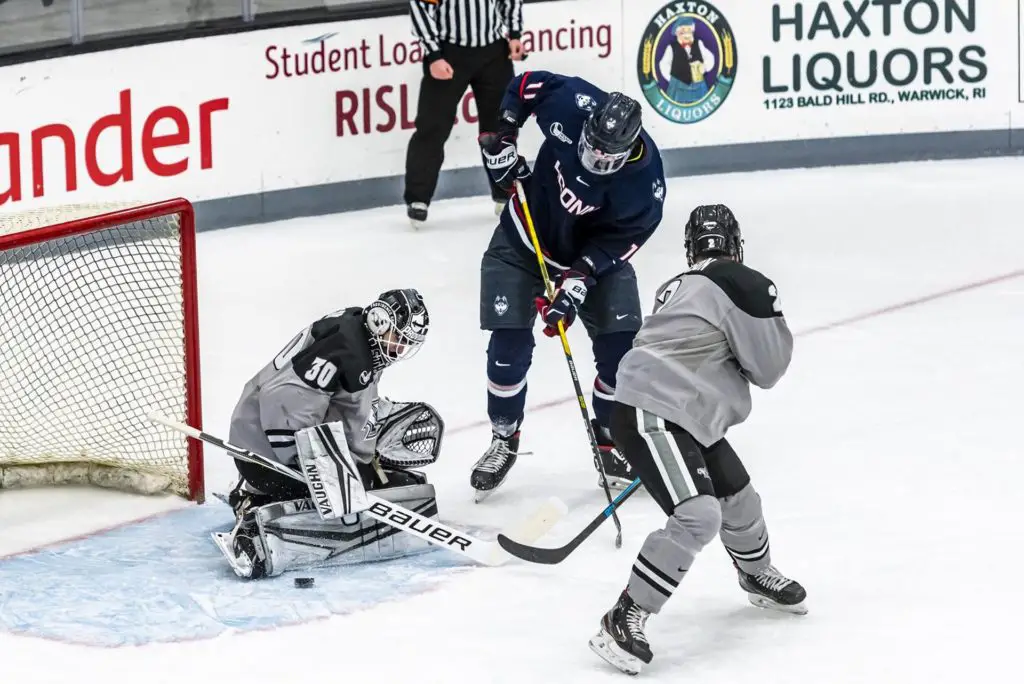
In a very challenging year, one thing was clear to first-year commissioner Steve Metcalf early in the 2020-21 Hockey East campaign
It took just a couple of weekends of canceled games and teams and the league working to change opponents to make Metcalf realize come season’s end, there would be a significant imbalance in both number of games played as well as the strength of opponents each team faces.
Thus, Metcalf turned to a somewhat familiar formula to help determine the Hockey East standings: the PairWise.
Used in the past as the determining factor to select the NCAA tournament, Metcalf, former chair of the men’s NCAA Division I men’s ice hockey committee, turned towards the familiar formula to help create the Hockey East Power Index (HEPI).
“We thought there was a big flaw with [using either] the points percentage or winning percentage,” said Metcalf. There’s imbalance and inequities with both the schedules and the strength of schedules. It’s one thing to have a disparity in games played, but it’s another concern when you have a disparity in strength of schedules.”
That forced the commissioner and the athletic directors to try to find a way to balance things out. In the past, the PairWise was a perfectly imperfect way to compare teams between conferences when picking the NCAA field. So Metcalf felt it would be an easily-understood way to rank the 11 Hockey East teams.
[The coaches] appreciate the fact we’re trying to be creative and develop something that was a better model for us,” Metcalf said. “The coaches are obviously very familiar with the PairWise and the statistical rankings that the NCAA uses. There’s a lot of similarities to what we’re doing to [the PairWise].”
Hockey East and Metcalf have remained mum on what the actual statistics are the are being used. But when you look at the current Hockey East Power Index (HEPI) and the current RPI, making some tweaks to account for overtime/shootout wins and losses, you can move the decimal point a couple of spots and almost match the HEPI.
That is neither here nor there, though. What might best explain the index is a simple exercise that Metcalf walked through.
He compared Connecticut and Northeastern. Northeastern is currently 8-5-2 while UConn is 8-8-2. By using a percentage of points-earned-per-points-available, Northeastern is .600, fourth best in Hockey East and UConn is .556, sixth in Hockey East. But in the HEPI, those two schools are transposed, UConn in fourth, which would be the final home-ice spot in the quarterfinals and Northeastern in sixth, one place short of a first-round bye.
The question is why. And all it takes it a two-minute glance at each team’s opponents.
UConn has played one of the toughest schedules thus far, including four games against Boston College and three against Massachusetts. Basically, 39 percent of its games have come against a top-10 opponent.
Northeastern, on the other hand, has played the easiest schedule in Hockey East to date. While they’ve played UMass twice and BC once, they’ve also faced last-place Vermont twice, 10th-place Merrimack four times and ninth-place New Hampshire twice.
“The important thing to know is that every game that everyone plays goes into the formula,” said Metcalf. “It’s not just how your team is doing. It’s how your opponent has done. And how the teams they have played have done. [The HEPI] is factoring in every game that is played [in Hockey East] this season and their results.
“It’s the old adage: Every game matters.”
Replacing Farrance one of BU’s biggest challenges
Despite being the final of the 51 men’s Division I teams playing hockey this season to get underway, one player on Boston University was raring to go right out of the gate.
BU blueliner David Farrance proved his offensive ability in the team’s first six games, scoring four goals and adding 10 assists. But he has missed four straight games and is anticipated to miss this weekend’s series against Connecticut.
Replacing a player of his caliber takes significant effort, but the Terriers have gone 3-1-0 over the four-game stretch, including a 3-1 win over No. 1 Boston College.
Coach Albie O’Connell says the ability to fill Farrance’s role has been a committee-like effort, but also pointed out certain individuals who have had impact.
“I think the guys have done a good job of it,” said O’Connell. “You look at [Alex] Vlasic. Suddenly he’s got three goals [in four games], had a game-tying and a game-winning [goal]. He’s really stepped up.”
He also points to Case McCarthy and Domenick Fensore, both of whom have had impact on the power play.
“Everyone knows Dave [Farrance] is an elite defenseman and he’s really good on the power play,” said O’Connell. “All the ‘D’ have stepped up, in general, but Vlasic has taken his game to a different level over the last three or four games.”
O’Connell said that Farrance is expected to be cleared to play for by next weekend, Feb. 26
Huskies to head overseas, represent U.S. in ’21-22 season
Northeastern announced this week that both its men’s and women’s hockey teams will head to Europe in December 2021.
Both have played in Belfast, Northern Ireland, in recent years but this time, the clubs will head to Lucerne, Switzerland to represent the United States at the FISU World University Games.
Northeastern will become the first university to have its hockey teams represent the U.S. in the tournament. In the past, Division I teams like Kansas, Baylor and Louisville have represented the U.S. in basketball.
Since 2001 for men’s hockey and 2011 for women’s hockey, the U.S. National University Team, which is traditionally organized by USA Hockey and composed of players that compete in the NCAA and ACHA), competes every two years in the Winter World University Games. Team USA has reached the medal round on the men’s side once in 2013, where it lost to Russia in the bronze medal game, taking fourth place. On the women’s side, Team USA won the bronze medal twice in 2013 and ’17. Last Winter Games in 2019, the women lost to Japan in overtime to finish fourth, while the men ended the competition in seventh place.


